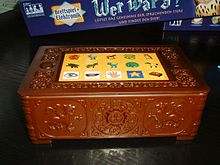Who was it?
| Who was it? | |
|---|---|
| Game data | |
| author | Pure Knizia |
| graphic | Graham Howells |
| publishing company | Ravensburger |
| Publishing year | 2007 |
| Art | Board game |
| Teammates | 2 to 4 |
| Duration | 30 - 45 minutes |
| Age | from age 6
|
| Awards | |
|
Children's Game of the Year 2008 |
|
Who was it? is a family game by game designer Reiner Knizia . The game is for two to four players, ages six and up, takes about 30–45 minutes and was published by Ravensburger in 2007 .
It won the 2008 Children's Game Critics' Prize and the 2008 German Children's Games Prize .
Theme and equipment
The content of the game box consists of:
- a game board with the castle rooms
- an electronic "magic chest"
- four pawns
- a ghost
- a cat
- nine pieces of food
- four keys
- four doors
- a special cube
- ten cardboard cards with pictures of the suspects
- a "magic ring"
- the game instructions
The players try as a team to find the thief of a magic ring together. At the crime scene, the king's castle, players rummage through the various rooms with their character. A different animal lives in each room. If the players feed the animal its favorite food, it becomes a friend. The players will only have this food with them if they find it somewhere while searching the rooms. Players can also discover hidden keys. For the food delicacies, the animals provide clues to the perpetrator: big or small, fat or thin, with or without a hat.
The progress of the game is regulated by rolling the dice and an electronic chest. The six-sided die has the numbers one to four and twice the image of a ghost on its sides. If the ghost appears, you move it one space further on your circuit and the player has to roll the dice again. Anyone who is surprised by the ghost outside the castle children's room has to go back there and start again.
Once in each new room, the players indicate in which room they are standing by pressing a button on the magic chest. This space is clearly determined by the animal present there. The players now have to decide what they want to do: either talk to the animal, search the room, “do magic” or unlock the chest (this is only possible if the players have already found a key). If you talk to the animal and have the required food with you, you will receive information about the perpetrator. When rummaging through the rooms, the players “find” pieces of food and keys. There are also levers that can open locked doors, as well as trap doors that transport players into the dungeon or the castle courtyard. With “magic” the players can find a secret passage, for example.
Little by little, more and more of the ten possible villains can be excluded. When the players feel confident that they have found the right burglar, they go into the suspect's room with the key. The electronic box reveals whether the players have made the right combination and have actually won. If the players make too many mistakes, the “evil wizard” wins.
Gameplay
The highlight of this family game is the mixture of cooperation , detective instinct, exciting story and good graphic and technical design . The game also has in common with the memory game that the players have to remember connections. Just like there, one should avoid writing down because it reduces the game's appeal.
The electronic chip ensures a wide range of game play options, as well as the three possible, adjustable levels of difficulty. At the simplest level, a “fairy godmother” often comes by and helps the players. At the most difficult level, adults are also challenged.
criticism
Game critics only criticized a few details. In the extensive rules for a family game, the player easily overlooks the fact that the default level of difficulty is set to "medium". This level is difficult to gain for beginners.
The critics found the battery dependency to be more serious: If the energy supply becomes weak, the current game simply stops and is not saved so that it can be continued later as soon as new batteries are inserted.
The official specification “from six years” is chosen too carefully. Even with five-year-olds, the game works without any problems. Four-year-olds usually play too long.
Web links
- Who was it? in the Luding games database
- Who was it? (Whoowasit?) In the board game database BoardGameGeek (English)
- Review at poeppelkiste.de
- "Fair play" game review by Harald Schrapers
- Photo series of the production at Zuspieler.de
- Rules of the game (PDF) on the website of Ravensburger Verlag (691 kB)
Individual evidence
- ↑ a b In the online game magazine H @ ll 9000 : detailed review
- ↑ poeppelkiste.de : Review ( Memento of the original from March 4, 2016 in the Internet Archive ) Info: The archive link was inserted automatically and has not yet been checked. Please check the original and archive link according to the instructions and then remove this notice.
- ↑ Martin Wehnert, review in the Oberhessische Presse on July 19, 2008


